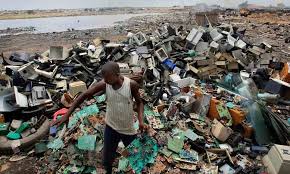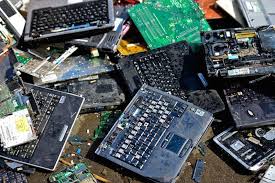Electronic waste commonly referred to as e-waste, is a term used to describe discarded electronic devices and equipment that have reached the end of their useful life or are no longer needed.
These items can include old computers, laptops, smartphones, tablets, televisions, appliances, and other electronic gadgets. E-waste may contain hazardous materials like lead, mercury, and various chemicals, making proper disposal and recycling essential to prevent environmental pollution and health risks.
In our modern world, electronic devices have become an integral part of our daily lives. From smartphones and laptops to televisions and kitchen appliances, we rely on these gadgets for communication, entertainment, and convenience.
However, with the rapid pace of technological advancement, these devices don’t last forever. When they reach the end of their useful life or are replaced by newer models, they often end up as electronic waste, or e-waste for short.
What is E-Waste?
E-waste refers to discarded electronic equipment, gadgets, and appliances that are no longer wanted or functional. This category includes items like old cell phones, outdated computers, broken TVs, and even kitchen appliances like microwave ovens. As our love for technology continues to grow, so does the amount of e-waste generated each year.
Why is E-Waste a Concern?
E-waste poses several significant challenges, and here’s why it’s a cause for concern:
1. Environmental Impact: Many electronic devices contain hazardous materials such as lead, mercury, and brominated flame retardants. When improperly disposed of, these toxic substances can leach into the soil and water, causing pollution and harm to ecosystems.
2. Health Risks: The improper handling of e-waste can have severe health consequences for those involved in recycling and disposal. Exposure to toxic substances can lead to health problems like respiratory issues, skin ailments, and even long-term diseases.
3. Resource Depletion: Electronics contain valuable materials like gold, silver, and rare metals. When e-waste is not recycled, these resources are lost, increasing the demand for mining and contributing to resource depletion.
4. Digital Divide: Discarded devices often end up in landfills, creating a digital divide as many people around the world lack access to technology. Recycling and refurbishing can help bridge this gap by making affordable devices available to underserved communities.
Read Also: Uncovering the Hidden Treasures of Yard Waste
The Role of Responsible E-Waste Management

To address these concerns, it’s crucial to adopt responsible e-waste management practices:
1. Reuse: Whenever possible, consider donating or selling your old electronics if they are still functional. This extends their lifespan and reduces the need for new devices.
2. Recycle: Recycling centers and e-waste programs exist to properly handle electronic devices. Recycling not only reduces environmental impact but also ensures the safe disposal of hazardous materials.
3. Educate: Spread awareness about the importance of e-waste recycling in your community. Encourage others to recycle their electronics responsibly.
4. Support Regulations: Advocate for and support government regulations that promote e-waste recycling and safe disposal practices.
Electronic waste is a growing concern in our tech-driven world. By understanding the environmental and health risks associated with e-waste and adopting responsible disposal and recycling habits, we can all play a part in mitigating these challenges. Let’s ensure that our love for gadgets doesn’t harm the planet or endanger our well-being.
The Importance of Electronic Waste (E-Waste)
In our fast-paced, technology-driven world, electronic devices have become an essential part of our lives. We use smartphones, laptops, and gadgets of all sorts to communicate, work, and have fun. But have you ever thought about what happens to these devices when we no longer need them? That’s where electronic waste, or e-waste, comes into the picture, and it’s more important than you might realize.
1. Protecting the Environment: E-waste contains many materials that can harm our environment if not handled properly. Inside your old gadgets, there might be substances like lead, mercury, and other chemicals.
When these devices end up in landfills or are disposed of incorrectly, these harmful materials can leak into the soil and water, polluting our planet. Responsible e-waste management helps prevent environmental damage and keeps our Earth clean.
2. Conserving Valuable Resources: Your old electronic devices are like treasure chests. They contain valuable materials like gold, silver, and rare metals. By recycling e-waste, we can recover these resources and reduce the need for mining. This not only helps protect natural habitats but also conserves resources for future generations.
3. Reducing Energy Consumption: Creating new electronic devices from scratch requires a lot of energy. When we recycle e-waste, we save energy because it takes less energy to refurbish and reuse materials than it does to make new ones. This means less pollution from power plants and a smaller carbon footprint.
4. Bridging the Digital Divide: Access to technology is essential in today’s world. However, many people, especially in underserved communities, don’t have access to affordable devices. Recycling and refurbishing old electronics can make these gadgets available at lower costs, helping bridge the digital divide and giving more people a chance to connect and learn.
5. Creating Jobs: Responsible e-waste management isn’t just good for the environment; it’s good for the economy too. Recycling centers and refurbishment programs create jobs in communities, offering employment opportunities and stimulating local economies.
6. Health and Safety: Improper handling of e-waste can be dangerous. Toxic substances found in electronics can harm the health of those involved in recycling and disposal. Responsible e-waste management ensures the safe handling and disposal of hazardous materials, protecting the health and safety of workers and communities.
7. Setting an Example: When we recycle e-waste, we set an example for others to follow. Our actions can inspire friends, family, and our communities to adopt eco-friendly practices and make a positive impact on the world.
Electronic waste, or e-waste, isn’t just a pile of old gadgets. It’s an opportunity to protect the environment, conserve resources, reduce energy consumption, bridge the digital divide, create jobs, and promote health and safety. By understanding the importance of responsible e-waste management and taking action, we can all contribute to a cleaner, greener, and more sustainable future for our planet.
Read Also: Sustainable Development: Building a Better Future for All
Electronic Waste Classification

Electronic waste, or e-waste, comes in various shapes and sizes, just like the electronic gadgets we use every day. To manage and recycle e-waste effectively, it’s important to classify it correctly. Let’s break down electronic waste classification in simple terms.
1. Large Appliances: This category includes big devices like refrigerators, washing machines, and air conditioners. They have complex components and can contain hazardous materials like refrigerants. Proper disposal and recycling of these appliances are essential to prevent environmental harm.
2. Small Appliances: Small appliances are the gadgets you find in your kitchen and around the house. Think of toasters, blenders, and coffee makers. While they are smaller, they still contain electrical components and should be recycled responsibly.
3. IT and Telecommunications Equipment: This category covers a wide range of electronics, including computers, laptops, printers, and routers. With technology constantly evolving, many of these devices become obsolete quickly. Recycling IT equipment helps recover valuable materials and reduce electronic waste.
4. Consumer Electronics: Here, we have the devices most of us use daily: smartphones, tablets, cameras, and gaming consoles. Due to frequent upgrades, these gadgets can pile up as e-waste. Proper disposal ensures that valuable components are recycled.
5. Lighting Equipment: Old fluorescent bulbs and energy-saving lamps fall into this category. They contain mercury, which is harmful if released into the environment. Recycling ensures safe handling of these materials.
6. Electrical and Electronic Tools: Power tools, drills, and lawnmowers with electronic parts are part of this group. Like other e-waste, they should be recycled to recover materials and reduce waste.
7. Toys, Leisure, and Sports Equipment: Even toys and sporting gadgets can become e-waste. Remote-controlled cars, gaming consoles, and electronic toys belong here. Recycling these items helps prevent unnecessary waste.
8. Medical Devices: This category includes electronic medical equipment like MRI machines, X-ray devices, and monitors. Proper disposal and recycling are vital due to the sensitive nature of these devices.
9. Monitoring and Control Instruments: These are devices used in industrial settings, such as sensors, control panels, and measuring instruments. Recycling these electronic components is crucial for both resource recovery and environmental protection.
10. Automatic Dispensers: Vending machines, ATM machines, and ticket machines fall into this group. Recycling these electronic components is not only responsible but can also be cost-effective.
Remember, the classification of e-waste helps ensure that each type of electronic device is handled appropriately. Recycling, refurbishing, and safely disposing of e-waste not only protect the environment but also contribute to conserving valuable resources. So, the next time you are ready to say goodbye to an old gadget, check its category and choose the right way to give it a second life or recycle it responsibly.
Read Also: What is Daisy Flower? benefits, Uses and Importance

